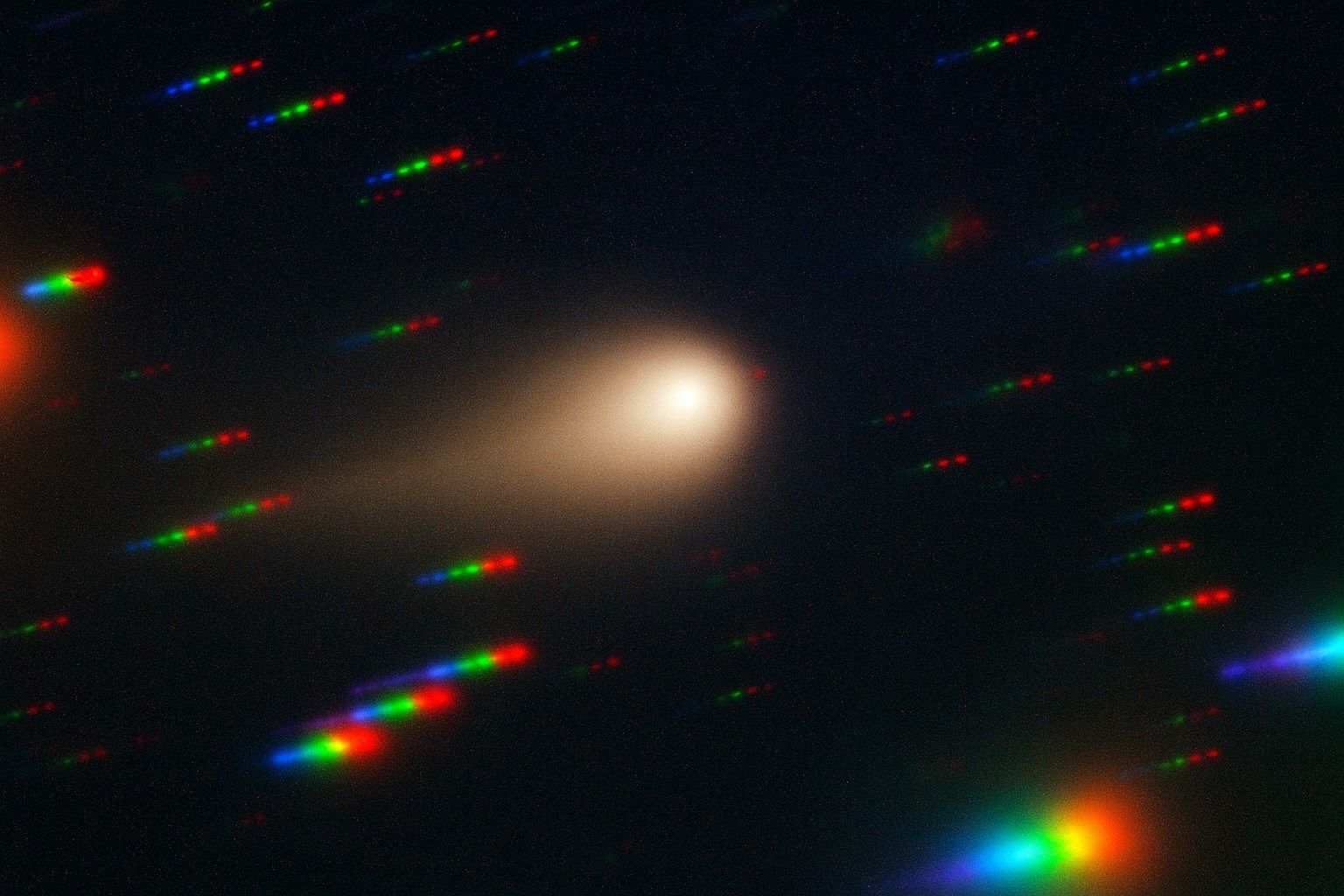- Rare Interstellar Comet: Comet 3I/ATLAS is only the third known object from beyond our Solar System, after 2017’s 1I/ʻOumuamua and 2019’s 2I/Borisov [1]. Discovered July 1, 2025 by the ATLAS survey telescope in Chile, its unbound hyperbolic path immediately flagged it as an interstellar visitor [2].
- One-Way Speedster: Hurtling through space at roughly 58 km/s (~130,000 mph), 3I/ATLAS is moving far faster than typical comets [3]. It’s on a one-way escape trajectory – after slingshotting around the Sun, it will race back into interstellar darkness, never to return [4].
- No Threat to Earth: The comet reached perihelion (closest to the Sun) around October 29–30, 2025 at about 1.36 AU (inside Mars’s orbit) [5]. It will remain far from Earth – its closest approach is ~1.8 AU (270 million km) in December 2025 [6] – so there is zero danger of any impact or ill effects [7].
- Too Faint to See: Despite media buzz, 3I/ATLAS has stayed too dim for naked-eye viewing. Around Halloween 2025 it was only about magnitude +11 and lost in the Sun’s glare [8]. It may reappear to telescopes by early December as it emerges from behind the Sun, but it will remain a faint smudge – never bright enough to spot without decent telescopic aid [9].
- Gigantic and Ancient: Initial observations suggest 3I/ATLAS’s icy core could be up to ~5 km across [10], potentially larger than Borisov (~1 km) or ʻOumuamua (~0.1 km). Based on its galactic trajectory, scientists estimate this comet may hail from the Milky Way’s ancient thick disk of stars and be 7–10 billion years old – older than our 4.6 billion-year-old Solar System [11].
- Unusual Composition & Activity: Unlike typical comets, 3I/ATLAS is extremely active even while far from the Sun. NASA’s Swift telescope saw it blasting out water vapor at ~40 kg/s (about the power of a “fire hose at full blast”) when it was still 2.9 AU from the Sun [12]. Its coma (gas halo) is rich in carbon dioxide but relatively low in H₂O and CO, and spectra detected gases like cyanide and even trace nickel vapor – clues that 3I/ATLAS formed in a very different stellar environment [13].
- Global Observation Frenzy: Telescopes worldwide (and even off-world) have mobilized to study this interstellar interloper. Hubble, James Webb, and major observatories like Gemini and the VLT have been tracking it for months [14]. In early October, as 3I/ATLAS passed ~30 million km from Mars, ESA’s Mars Express and ExoMars Trace Gas Orbiter snapped images – the first time spacecraft around another planet photographed an interstellar object [15]. Upcoming, ESA’s JUICE probe (near Jupiter) and even NASA’s Europa Clipper may sample the comet’s tail as it drifts outward [16]. Scientists are seizing this once-in-a-lifetime opportunity to examine a piece of another star system up close [17].
- Not Alien, But Fascinating: Nicknamed a “ghost comet” during its Halloween flyby, 3I/ATLAS spurred wild speculation. A Harvard astronomer even mused about alien technology, calling perihelion an “acid test” of artificial behavior [18]. Experts strongly refute those claims – no unusual signals or maneuvers have been detected. “It looks like a comet and it behaves like a comet,” one ESA scientist emphasized, noting no evidence of anything artificial [19]. In short, aside from its exotic origin, 3I/ATLAS is acting like a natural comet – just one that formed around a different sun.
A Visitor From Beyond the Solar System
On July 1, 2025, astronomers in Chile spotted a faint, fast-moving object that immediately stood out. Follow-up measurements showed it was on a hyperbolic orbit – not bound to our Sun – confirming it came from interstellar space [20]. The discovery was officially designated 3I/ATLAS, where “3I” denotes the third Interstellar object ever observed, and “ATLAS” credits the NASA-funded Asteroid Terrestrial-impact Last Alert System survey that found it [21].
This find electrified scientists. “This is only the third such interstellar comet we’ve ever been able to study, and planetary scientists are super excited to learn about what comets in other solar systems are like,” said Jason Wright, an astronomer at Penn State [22]. Every planet, moon, and comet we’ve seen up to now originated in our Solar System – but 3I/ATLAS is a true outsider, carrying clues from a world beyond our own [23]. It offers a rare chance to sample material from another star’s planetary disk, essentially a frozen messenger from a far-off system.
Interstellar Family: 1I, 2I, and Now 3I
3I/ATLAS follows in the footsteps of two prior interstellar visitors. The first was 1I/ʻOumuamua in 2017, a mysterious needle-shaped object that lacked any visible coma (leading to rampant speculation about its nature). The second, 2I/Borisov in 2019, was an active icy comet that looked and behaved much like small comets from our own Oort Cloud. By comparison, Comet 3I/ATLAS appears more like Borisov – an active comet venting gas and dust – rather than a strange inert rock [24]. In fact, Hubble images of 3I/ATLAS clearly show a fuzzy coma and a faint tail, confirming it’s spewing material as sunlight heats its surface [25]. This dispelled any early doubts: NASA officially confirmed 3I/ATLAS is a comet (not an asteroid) once telescopes saw its halo of gas and dust [26].
What truly sets 3I/ATLAS apart is its scale and age. It may be larger than both ʻOumuamua and Borisov, with Hubble data suggesting a nucleus up to ~5.6 km wide [27]. And it’s likely far older. Researchers calculate that based on its trajectory through the Milky Way, 3I/ATLAS could be 7–10 billion years old, meaning it formed long before our Sun existed [28]. “We think there’s a two-thirds chance this comet is older than the Solar System, and that it’s been drifting through interstellar space ever since,” notes Oxford astronomer Chris Lintott [29]. In other words, 3I/ATLAS may be a time capsule from an early era of our galaxy – a preserved remnant of a planet-forming disk around some ancient star.
Discovery and Orbit of 3I/ATLAS
ATLAS’s telescopes first picked up the intruder in a starry patch of sky on July 1, 2025 [30]. Within days, observatories worldwide confirmed an extremely eccentric orbit (e ≈ 6.14) that is open-ended rather than elliptical [31]. The comet came flying in from far above the plane of the planets on a steep retrograde path (inclination ~175°) [32]. Such an orbit is a glaring tip-off: 3I/ATLAS is not gravitationally bound to our Sun. It arrived from interstellar space on a one-time visit, and after it swings past the Sun, it will depart the Solar System for good [33] [34].
At discovery, 3I/ATLAS was out near Jupiter’s orbit and faint, around magnitude 18 [35]. But its inbound trajectory was quickly charted. It sped through the inner Solar System throughout 2025, reaching perihelion on October 29, 2025 at a distance of ~1.36 AU (203 million km) from the Sun [36] – just inside the orbit of Mars. Notably, at perihelion the comet was positioned on the far side of the Sun from Earth, hidden by solar glare [37]. This solar conjunction meant ground observers temporarily lost sight of it during its moment closest to the Sun.
After rounding the Sun, 3I/ATLAS is now headed back toward deep space on a hyperbolic escape path. It will remain well beyond Earth’s vicinity. In fact, its nearest pass by Earth will be on December 19, 2025, at about 1.8 AU (~270 million km) away [38]. This is nearly twice the Earth–Sun distance – so distant that our planet and the comet won’t have any notable interaction (for context, Mars is ~0.5–1 AU from Earth depending on alignment). NASA and the Minor Planet Center have stressed that all orbital solutions confirm 3I/ATLAS will remain safely far from Earth, now and in the foreseeable future [39]. The comet will quietly slip past Jupiter’s orbit around March 2026 and then continue its outbound journey into interstellar space [40], never to return.
A Cosmic Bullet (Speed and Trajectory)
Even among comets, 3I/ATLAS is a speed demon. As it whipped around the Sun at perihelion, it reached a blistering ~68 km/s relative to the Sun [41] – the fastest speed ever recorded for a comet-like object [42]. For comparison, typical long-period comets from our Oort Cloud mosey at a few tens of km/s. 3I/ATLAS’s extreme velocity is essentially its interstellar “fingerprint”: it needed to be that fast to escape its original star’s gravity, and it’s moving too fast for our Sun to hang onto it either [43].
“It’s like glimpsing a rifle bullet for a thousandth of a second,” said UCLA astronomer David Jewitt in describing how fleeting and hard-to-catch this visitor is [44]. Because of this enormous speed, the Sun’s gravity only bent 3I/ATLAS’s path a little; the comet zoomed by and is already on its way out. After perihelion, as it climbs away from the Sun, it will slow slightly but still achieve a final escape velocity around 58 km/s (v∞) as it leaves the Solar System [45].
For skywatchers, the unfortunate consequence of 3I/ATLAS’s trajectory is that it never got very close to Earth or the inner Solar System. It stayed at Mars-like distances or beyond, so it never grew very bright in our skies. Around the time of its October flyby, some media dubbed it the “Halloween ghost comet,” but in reality 3I/ATLAS was only ~mag +11 at the end of October – far below naked-eye visibility [46]. Moreover, it was near the Sun’s direction in the sky, making it effectively invisible against twilight. As NASA noted, the comet should become observable again with telescopes by early December 2025 once it emerges from solar glare [47]. However, by then it will be even farther away and fading, so only large amateur or professional telescopes will detect it as a tiny fuzzy dot. It is never expected to become a bright “Great Comet” that casual stargazers could see without aid [48].
Scientific Findings: Composition, Activity, and Origin Clues
Though 3I/ATLAS has been a challenging target to see visually, it has proven to be a treasure trove of data for scientists. Dozens of observatories – on Earth and in space – have been scrutinizing its light to decode its composition and behavior. The emerging picture is a comet that is familiar in some ways yet oddly different in others. It behaves much like comets from our Solar System, with volatile ices sublimating and creating a coma and tail. But the chemistry of those ices and the timing of its activity hint at a very different origin story.
One early surprise was just how active 3I/ATLAS became long before it neared the Sun. By late summer 2025, when the comet was still out near Jupiter’s orbit, astronomers already observed it developing a noticeable coma and tail [49]. Typically, comets don’t wake up and start outgassing heavily until they are much closer (around the asteroid belt or Mars’s orbit). Yet 3I/ATLAS “turned on” early. In July, NASA’s Neil Gehrels Swift space telescope detected clear signs of water vapor even while the comet was 2.9 AU from the Sun [50]. Swift’s ultraviolet instrument picked up lots of hydroxyl (OH) – a fragment of water molecules – indicating substantial water ice sublimating at that great distance [51]. Researchers calculated the comet was shedding on the order of 40 kg of water per second at 2.9 AU [52]. That outgassing rate, roughly 88 pounds per second, is comparable to a high-pressure firehose blasting water continuously [53]! Seeing such copious water emission when the comet was three times farther from the Sun than Earth rewrote some of scientists’ assumptions about comet physics [54]. It suggests 3I/ATLAS contains very volatile ices (like subsurface water ice) that got exposed and began evaporating much earlier than usual. “When we detect water… from an interstellar comet, we’re reading a note from another planetary system,” said Dennis Bodewits, a Swift team scientist, emphasizing the excitement of seeing familiar ingredients (like water) coming from an alien comet [55].
Analyzing the makeup of 3I/ATLAS has been a top priority. By splitting the comet’s light into a spectrum, scientists can identify which gases are present in the coma and thus infer the ices in the nucleus. Early results from NASA’s James Webb Space Telescope (JWST) and ESA’s ground-based instruments revealed an unusual chemical balance. The comet’s coma appears to be dominated by carbon dioxide (CO₂) gas, with comparatively little water vapor. One analysis suggested the gas around 3I/ATLAS might be on the order of 95% CO₂ and only ~5% H₂O by volume, essentially the opposite of a typical comet from our Solar System [56]. In our local comets, water is usually the main volatile released; seeing a comet with mostly CO₂ implies it formed under very different conditions.
Moreover, astronomers noted that 3I/ATLAS’s spectrum showed very low levels of carbon monoxide (CO) [57]. CO is a highly volatile ice that in young comets is often plentiful, but 3I/ATLAS seems to have lost most of its CO long ago – likely “baked out” during its history [58]. “It was well baked and boiled in its original system,” one scientist remarked, meaning the comet probably spent time relatively close to its original star (or experienced some heating) that drove off the most fragile ices [59]. Instead, tougher volatiles like CO₂ remain as major components.
Along with the carbon dioxide, other gases detected include familiar ones like cyanide (CN) – a common comet gas – but also some surprises. One was the discovery of nickel vapor (Ni) in the comet’s coma [60]. Heavy metal atoms like nickel and iron have been observed in trace amounts in the comas of some Solar System comets, but usually only when they get relatively close to the Sun. Detecting nickel vapor while 3I/ATLAS was still far out was unexpected. Scientists think the nickel might be carried in an unusual molecular form: possibly nickel tetracarbonyl, a volatile compound of nickel and carbon monoxide that can survive as ice and then break apart near the Sun, releasing Ni atoms [61]. This kind of exotic chemistry is giving researchers fresh clues about the environment in which 3I/ATLAS formed. It likely condensed in a carbon-rich, metal-infused protoplanetary disk around another star, where certain molecules (like carbon monoxide and carbon dioxide) were abundant while others were depleted.
In sum, the composition studies so far portray 3I/ATLAS as carbon-rich and ancient. Its volatile inventory has more in common with the outer, carbon-dioxide-heavy regions of planetary systems. The comet may have originated around a star in the galaxy’s thick disk billions of years ago [62] [63]. Over eons, it was ejected into interstellar space – possibly by a passing star or giant planet – carrying with it a frozen record of its birthplace. Now that it’s passing through our Solar System, every molecule we detect is a chemical postcard from that alien system. As one astronomer put it, studying 3I/ATLAS is like analyzing “a sample from a bygone era of the cosmos,” potentially revealing how planetary building blocks differed around other suns.
Bizarre Sunward “Jet”
Among the more eye-catching findings was an odd sunward-pointing plume observed in late August 2025. Normally, a comet’s tail streams away from the Sun (blown by the solar wind and radiation), but images from Hawaii’s Keck Observatory and others showed a bright narrow spike of dust and gas protruding toward the Sun from 3I/ATLAS [64]. This feature, essentially an “anti-tail,” extended roughly 10,000 km out from the nucleus in the sunward direction [65]. Anti-tails can occur in comets due to perspective effects or large dust grains aligning along the comet’s orbital path, but seeing a dramatic sunward jet like this was unexpected for 3I/ATLAS. It created a briefly bizarre geometry – a comet apparently sprouting a spike toward the Sun rather than a tail flowing away. Scientists noted this anti-tail phenomenon likely indicated a burst of dust emission, perhaps as volatile-rich patches on the nucleus caught sunlight and vented material in an unusual way [66]. The sunward jet eventually dissipated or realigned as the viewing angle changed, but it was a reminder that 3I/ATLAS is full of surprises, behaving in ways that keep astronomers on their toes.
An Unprecedented Observation Campaign
3I/ATLAS’s visit has sparked an unprecedented global observation campaign. Given the rarity of interstellar objects, astronomers around the world (and across different space agencies) coordinated intensely to gather as much data as possible during the comet’s brief sojourn through our Solar System. Practically every major telescope that could observe 3I/ATLAS has been turned its way.
NASA’s Hubble Space Telescope imaged the comet as early as July 2025, capturing a teardrop-shaped coma and setting size limits on its nucleus [67]. The James Webb Space Telescope (JWST) observed 3I/ATLAS in infrared, enabling the detailed compositional analysis (CO₂, H₂O, etc.) described above [68]. NASA also tasked the Swift satellite (normally a gamma-ray observatory) to monitor the comet’s UV emissions, resulting in the water detection at 2.9 AU [69]. Even the Transiting Exoplanet Survey Satellite (TESS) and the new SPHEREx mission joined in plans to watch the comet [70], highlighting how valuable this object is across disciplines.
On the ground, huge observatories like Gemini South in Chile (which took a striking early image of the comet in August), the Very Large Telescope (VLT) in Europe, Keck in Hawaii, and others have all contributed images and spectra. Smaller regional observatories and countless amateur astronomers with high-end telescopes also tracked 3I/ATLAS’s progress when possible, contributing to a rich flow of data.
Uniquely, spacecraft around other planets got involved – a first in the study of interstellar objects. On October 3, 2025, as 3I/ATLAS passed about 30 million km from Mars, scientists seized the chance to observe it from the Red Planet’s vicinity. ESA directed its Mars Express orbiter and the ExoMars Trace Gas Orbiter to point their cameras at the comet [71]. The target was extremely faint (10,000–100,000 times dimmer than typical targets, one scientist noted) [72], but both spacecraft managed to photograph 3I/ATLAS as a tiny hazy dot [73]. While not much to look at, these were the closest images ever taken of an interstellar comet – an historic milestone [74]. (NASA’s Mars Reconnaissance Orbiter also attempted observations, though a U.S. government shutdown in October delayed release of those images [75].) This Mars-based campaign demonstrated the creative strategies astronomers are using: when the comet was hidden from Earth by the Sun, they watched it from Mars, ensuring continuous coverage.
Looking ahead, more spacecraft will soon join the action. In November 2025, ESA’s Jupiter Icy Moons Explorer (JUICE) – which is in the outer Solar System – is scheduled to attempt observations of 3I/ATLAS during its brightest post-perihelion phase [76]. JUICE carries cameras, spectrometers, and particle detectors that could yield unique data on the comet’s activity and the particles it releases. Coordination with NASA’s upcoming Europa Clipper mission (also en route to Jupiter’s vicinity) is being explored, since both spacecraft have ultraviolet spectrographs that might jointly observe the comet’s composition [77]. Additionally, as 3I/ATLAS’s expanding tail drifts outward, there’s a possibility spacecraft in the solar system could literally sample the comet’s tail particles: one analysis suggested NASA’s Psyche probe (traveling between Earth and Mars) and ESA’s Hera asteroid mission might pass through the fringes of the tail in the weeks after perihelion [78]. Even NASA’s Juno spacecraft at Jupiter and various heliospheric probes could detect charged particles shed by 3I/ATLAS. In essence, the comet is being watched from every angle imaginable – a coordinated, multi-platform observation campaign rarely seen for any celestial object.
All these efforts underscore the scientific community’s eagerness to maximize this fleeting opportunity. “Scientists are seizing this once-in-a-lifetime chance to study an alien comet up close,” noted one Space.com report [79]. Indeed, no one knows when the next interstellar visitor might appear – it could be years or decades – so 3I/ATLAS is being treated as a cosmic priority target. The data collected will keep researchers busy for a long time, parsing out clues about the comet’s origin and what it can teach us about other solar systems.
Extraterrestrial Theories vs. Scientific Reality
Whenever an enigmatic object from beyond the Solar System grabs headlines, it’s almost inevitable that whispers of “aliens” will follow. In 2017, ʻOumuamua famously sparked theories that it might be an alien probe due to its odd shape and unexpected acceleration. With 3I/ATLAS, the situation has been similar: its interstellar nature and some unusual traits led to fevered speculation in certain corners of the internet.
One prominent voice has been Harvard astronomer Avi Loeb, known for pushing the idea of extraterrestrial technology. Loeb publicly mused that 3I/ATLAS could conceivably be an artificial object and urged vigilance. Through his Galileo Project – which investigates potential alien artifacts – Loeb asked provocative questions about whether the comet might be generating its own light or even harboring “active intelligence” [80] [81]. As 3I/ATLAS approached perihelion, he dubbed it an “acid test” to see if the object would behave in any non-natural way [82]. After perihelion, Loeb claimed to calculate a slight “non-gravitational acceleration” of the comet (a tiny deviation in its motion, potentially due to outgassing) and suggested it could hint at something unusual if not accompanied by visible outgassing [83] [84].
Mainstream scientists, however, have overwhelmingly rejected the alien hypothesis. As soon as detailed observations came in, the consensus was that 3I/ATLAS looks and behaves just like a typical comet – albeit a big and distant one. NASA weighed in decisively: “It looks like a comet. It does comet things. It very, very strongly resembles, in just about every way, the comets that we know,” Dr. Tom Statler, NASA’s lead for solar system small bodies, told The Guardian [85]. In other words, nothing in the data suggests an artificial origin. The comet’s material outgassing explains its motions; its brightness is clearly from reflected sunlight and sublimating ices, not any internal power source [86]. Even Prof. Loeb himself conceded in a blog update that “the simplest hypothesis is that 3I/ATLAS is a comet,” clarifying that his aim was to provoke thought, not claim proof of aliens [87].
Other experts have been more blunt. “Social media lit up with wild claims, but there’s no evidence whatsoever of anything artificial,” stressed ESA scientist Michael Küppers [88]. No mysterious signals, no maneuvers, no anomalous features beyond what nature can do. The comet’s slight acceleration near the Sun is fully explainable by jets of gas (a common effect in active comets). And the “Manhattan-sized spacecraft” notion – a dramatic comparison Loeb made – simply refers to the size of the comet’s coma, not a solid craft. As one astronomer quipped, the only thing otherworldly about 3I/ATLAS is its age and origin, not its nature.
In fact, far from being disappointed, scientists are thrilled that 3I/ATLAS is a natural comet. That means we can apply everything we’ve learned from studying home-grown comets to interpret this visitor. Every observation of 3I/ATLAS can be grounded in known physics and chemistry, allowing meaningful comparisons. It’s opening a window on cometary science on a galactic scale – confirming, for example, that water ice and organic compounds (the stuff of life’s chemistry) exist around other stars and survive billions of years in interstellar space [89]. As planetary scientist Jason Wright noted, studying such an object helps us learn “what comets in other solar systems are like” [90], which was once pure speculation but is now empirical reality.
Latest Updates (November 2025) and What’s Next
As of November 1, 2025, Comet 3I/ATLAS is on the outbound leg of its solar visit. It survived its perihelion swing-by intact (no signs of breaking apart were observed) and is now gradually dimming as it recedes. In late October, scientists eagerly analyzed data from the perihelion period – the time when the comet was closest to the Sun and most active. Even though 3I/ATLAS was behind the Sun from Earth’s perspective at that moment, space telescopes like Hubble and various spacecraft continued collecting data. Any post-perihelion changes (such as spikes in activity or fragmentation) would have been noted, but so far 3I/ATLAS appears to be behaving normally as an active comet cooling off after solar heating.
By mid-November, the comet will likely become observable again in the dawn sky with large telescopes, climbing away from the Sun’s glare. Its brightness is expected to peak around that time at roughly magnitude 11–12 – quite faint – and then diminish. The closest approach to Earth on Dec 19, 2025 will still be a distant 1.8 AU, but it offers a final window for observations from Earth’s night side [91]. Professional observatories are planning to take advantage of December and January while the comet is still in reach, before it slips away for good. Amateur astronomers with at least 8–10 inch telescopes might attempt to spot the interstellar vagabond in December, though it will be a challenging target low on the horizon.
Meanwhile, data analysis is in full swing. Scientists are poring over spectra from JWST, images from Hubble, and measurements from instruments on Mars orbiters, piecing together a comprehensive story of 3I/ATLAS. Already, papers are being written detailing its composition, rotation (early observations suggest it rotates roughly every 16 hours [92]), and the dust properties of its coma. The Minor Planet Center continues to refine the comet’s trajectory with new observations, improving our knowledge of where 3I/ATLAS came from and where it’s heading. Preliminary orbit computations suggest it came from the direction of the constellation Draco, but pinpointing an exact stellar system of origin is extremely difficult given the “rifle bullet” speed (tiny uncertainties translate into huge positional differences over billions of years) [93]. David Jewitt noted the challenge of pinning down the comet’s exact birthplace when it’s moving so fast and has roamed the galaxy for eons [94].
In the longer term, the legacy of 3I/ATLAS will feed into future missions and strategies. Both NASA and ESA have been studying concepts to intercept interstellar objects if one is discovered on a suitable path. A mission called Comet Interceptor, already approved by ESA, aims to park a probe in space and await a fresh comet – possibly even an interstellar one – to fly by and study up-close [95]. The excitement surrounding 3I/ATLAS will likely bolster support for such missions. It has shown that interstellar comets can be active, large, and incredibly scientifically rich. If we could one day visit one with a spacecraft, we could directly sample primordial material from another star system – a tantalizing prospect for astrobiology and planetary science.
For now, humanity will bid farewell to Comet 3I/ATLAS around the end of 2025 as it slips beyond the reach of our instruments. But the lessons it leaves behind are profound. In just a few months, this ancient traveler has confirmed that the building blocks of planets and comets are universal – water, carbon-bearing compounds, even metals like nickel can be found in comets from other stars [96]. It has demonstrated that other planetary systems can cast off debris that wanders the galaxy for billions of years, occasionally paying us a visit. And it has given us a sense of the diversity (and commonality) of small bodies beyond our Solar System.
As 3I/ATLAS sails off into the cosmic night, astronomers will be watching and waiting for the next interstellar visitor. Whether it comes next year or decades from now, we’ll be better prepared thanks to the wealth of knowledge gleaned from this one. Until then, 3I/ATLAS will remain a symbol of our first steps toward exploring the galaxy’s debris – not by leaving home, but by studying what drifts into our neighborhood. In the words of one researcher, objects like 3I/ATLAS are “messengers from afar,” and this comet’s message is still being deciphered, promising to deepen our understanding of the broader universe we live in [97].
Sources: Comet 3I/ATLAS Wikipedia [98] [99]; ESA FAQ on 3I/ATLAS [100] [101]; TechStock² (TS2) astronomy reports [102] [103] [104] [105]; Newsweek interviews [106] [107]; Space.com and Live Science coverage [108] [109]; Minor Planet Center data [110] [111].
References
1. ts2.tech, 2. ts2.tech, 3. ts2.tech, 4. ts2.tech, 5. ts2.tech, 6. ts2.tech, 7. ts2.tech, 8. ts2.tech, 9. ts2.tech, 10. ts2.tech, 11. ts2.tech, 12. ts2.tech, 13. ts2.tech, 14. ts2.tech, 15. ts2.tech, 16. ts2.tech, 17. ts2.tech, 18. ts2.tech, 19. ts2.tech, 20. ts2.tech, 21. ts2.tech, 22. www.newsweek.com, 23. www.esa.int, 24. ts2.tech, 25. ts2.tech, 26. www.euronews.com, 27. ts2.tech, 28. ts2.tech, 29. ts2.tech, 30. ts2.tech, 31. ts2.tech, 32. ts2.tech, 33. www.newsweek.com, 34. ts2.tech, 35. en.wikipedia.org, 36. ts2.tech, 37. ts2.tech, 38. www.newsweek.com, 39. www.newsweek.com, 40. www.newsweek.com, 41. ts2.tech, 42. ts2.tech, 43. ts2.tech, 44. ts2.tech, 45. ts2.tech, 46. ts2.tech, 47. ts2.tech, 48. ts2.tech, 49. ts2.tech, 50. ts2.tech, 51. ts2.tech, 52. ts2.tech, 53. ts2.tech, 54. ts2.tech, 55. ts2.tech, 56. en.wikipedia.org, 57. ts2.tech, 58. ts2.tech, 59. ts2.tech, 60. ts2.tech, 61. ts2.tech, 62. ts2.tech, 63. ts2.tech, 64. ts2.tech, 65. ts2.tech, 66. ts2.tech, 67. ts2.tech, 68. en.wikipedia.org, 69. ts2.tech, 70. ts2.tech, 71. ts2.tech, 72. ts2.tech, 73. ts2.tech, 74. ts2.tech, 75. ts2.tech, 76. ts2.tech, 77. www.esa.int, 78. ts2.tech, 79. ts2.tech, 80. www.euronews.com, 81. www.euronews.com, 82. ts2.tech, 83. www.newsweek.com, 84. www.newsweek.com, 85. www.euronews.com, 86. www.euronews.com, 87. www.euronews.com, 88. ts2.tech, 89. ts2.tech, 90. www.newsweek.com, 91. www.newsweek.com, 92. en.wikipedia.org, 93. ts2.tech, 94. ts2.tech, 95. www.esa.int, 96. ts2.tech, 97. ts2.tech, 98. en.wikipedia.org, 99. en.wikipedia.org, 100. www.esa.int, 101. www.esa.int, 102. ts2.tech, 103. ts2.tech, 104. ts2.tech, 105. ts2.tech, 106. www.newsweek.com, 107. www.euronews.com, 108. ts2.tech, 109. ts2.tech, 110. en.wikipedia.org, 111. en.wikipedia.org










